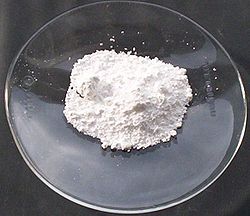 | |
 | |
| Names | |
|---|---|
| IUPAC name lead(II) sulfate | |
| Other names Anglesite, fast white, milk white, plumbous sulfate | |
| Identifiers | |
3D model (JSmol) | |
| ChemSpider | |
| ECHA InfoCard | 100.028.362 |
| EC Number |
|
PubChem CID | |
| UNII | |
| UN number | 1759 1794 |
CompTox Dashboard (EPA) | |
| |
| |
| Properties | |
| Pb S O 4 | |
| Molar mass | 303.26 g/mol [1] [2] |
| Appearance | white solid |
| Density | 6.29 g/cm3 [3] |
| Melting point | 1,087 °C (1,989 °F; 1,360 K) decomposes |
| 0.0032 g/100 mL (15 °C) 0.00425 g/100 mL (25 °C) [4] | |
Solubility product (Ksp) | 2.13 x 10−8 (20 °C) |
| Solubility | insoluble in alcohol soluble in ammonium acetate (≥ 6 mol/L) soluble in ammonium tartrate in presence of ammonium chloride and ammonia Contents |
| −69.7·10−6 cm3/mol | |
Refractive index (nD) | 1.877 |
| Structure | |
| orthorhombic, barite | |
| Thermochemistry | |
Heat capacity (C) | 103 J/degree mol |
Std molar entropy (S⦵298) | 149 J·mol−1·K−1 [5] |
Std enthalpy of formation (ΔfH⦵298) | −920 kJ·mol−1 [5] |
| Hazards | |
| GHS labelling: | |
   | |
| Danger | |
| H302, H332, H360Df, H410 | |
| P201, P202, P260, P261, P264, P270, P271, P273, P281, P301+P312, P304+P312, P304+P340, P308+P313, P312, P314, P330, P391, P405, P501 | |
| NFPA 704 (fire diamond) | |
| Flash point | Non-flammable |
Threshold limit value (TLV) | 0.15 mg/m3 |
| Related compounds | |
Other anions | Lead(II) chloride, Lead(II) bromide, Lead(II) iodide, Lead(II) fluoride |
Other cations | Tin(II) sulfate, Sodium sulfate, Copper(II) sulfate |
Except where otherwise noted, data are given for materials in their standard state (at 25 °C [77 °F], 100 kPa). | |
Lead(II) sulfate (PbSO4) is a white solid, which appears white in microcrystalline form. It is also known as fast white, milk white, sulfuric acid lead salt or anglesite.
It is often seen in the plates/electrodes of car batteries, as it is formed when the battery is discharged (when the battery is recharged, then the lead sulfate is transformed back to metallic lead and sulfuric acid on the negative terminal or lead dioxide and sulfuric acid on the positive terminal). Lead sulfate is poorly soluble in water.


